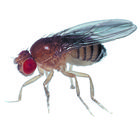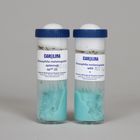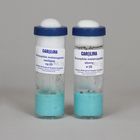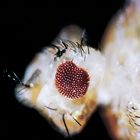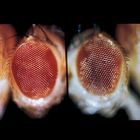Introductory Genetics with Drosophila

Carolina Labsheets™
Drosophila is one of the most popular model organisms for the study of genetics. This LabSheet can be used with a variety of our Drosophila cultures and sets in studies of monohybrid, dihybrid, and sex-linked crosses. The following crosses are especially recommended for introductory genetics activities although many others can be done. See our complete listing of Drosophila cultures for additional possibilities.
Monohybrid Crosses
| apterous × wild | Needed cultures: 172320 apterous (wingless) and 172100 wild type. Available as set 171904. Apterous (ap) is recessive to wild type and is located on chromosome 2. The expected F2 ratio is 3 wild type: 1 apterous. |
| vestigial × wild | Needed cultures: 172460 vestigial (reduced wings) and 172100 wild type. Available as set 171905. Vestigial (ve) is recessive to wild type and is located on chromosome 2. The expected F2 ratio is 3 wild type: 1 apterous. |
| sepia × wild | Needed cultures: 172575 sepia (dark brown-eyed) and 172100 wild type. Sepia (se) is recessive to wild type and is located on chromosome 3. The expected F2 ratio is 3 wild type: 1 sepia. |
Dihybrid Crosses
| apterous × sepia | Needed cultures: 172320 apterous (wingless) and 172575 sepia (dark brown-eyed). Apterous (ap) is recessive to wild type and is located on chromosome 2. Sepia (se) is recessive to wild type and is located on chromosome 3. Apterous flies are wild type for eye color, and the sepia flies are wild type for wings. The expected F2 ratio is 9 normal wings, red eyes: 3 normal wings, sepia eyes: 3 apterous, red eyes: 1 apterous, sepia eyes. |
| vestigial × sepia | Needed cultures: 172460 vestigial (reduced wings) and 172575 sepia (dark brown-eyed). Vestigial (vg) is recessive to wild type and is located on chromosome 2. Sepia (se) is recessive to wild type and is located on chromosome 3. Vestigial flies are wild type for eye color, and the sepia flies are wild type for wings. The expected F2 ratio is 9 normal wings, red eyes: 3 normal wings, sepia eyes: 3 vestigial, red eyes: 1 vestigial, sepia eyes. |
| vestigial × ebony | Needed cultures: 172460 vestigial (reduced wings) and 172500 ebony (dark-bodied). Available as set 171915. Vestigial (vg) is recessive to wild type and is located on chromosome 2. Ebony (eb) is recessive to wild type and is located on chromosome 3. Vestigial flies are wild type (tan) for body color and the ebony flies are wild type for wings. The expected F2 ratio is 9 normal wings, normal body color: 3 normal wings, dark body: 3 vestigial, normal body color: 1 vestigial, dark body. |
Sex-linkage
| white × wild | Needed cultures: 172220 white (white eyes) and 172100 wild type. Available as set 171910. White (w) is recessive and is located on chromosome 1. Chromosome pair 1 consists of the sex chromosomes. The locus for white is on a position on the X chromosome that has no homolog on the Y; thus, white is inherited only through the X chromosome, making white a sex-linked (or X-linked) gene. |
Needed Materials
F1 Drosophila Cultures
empty culture vials and plugs (173076)
Formula 4-24® Instant Drosophila Medium (173200)
Drosophila sorting brushes (173094)
index cards to use as sorting trays
Carolina™ Drosophila Manual (452620)
Optional Materials
Carolina Drosophila Stand (173030)
Our 173050 Drosophila Culture Kit includes 36 vials and plugs, labels, FlyNap® Kit, Formula 4-24®, sorting brushes, sorting cards, and a Carolina™ Drosophila Manual.
Safety
Ensure that students understand and adhere to safe laboratory practices when performing any activity in the classroom or lab. Demonstrate the protocol for correctly using the instruments and materials necessary to complete the activities, and emphasize the importance of proper usage. Use personal protective equipment such as safety glasses or goggles, gloves, and aprons when appropriate. Model proper laboratory safety practices for your students and require them to adhere to all laboratory safety rules.
 Procedures
Procedures
Students can work individually or in groups of 2–4.
When your cultures arrive, open the package immediately and inspect the cultures to verify that they have arrived in good condition. Examine the label on each vial. The label gives the name of the culture (wild, sepia, etc.) and, for mutants, the genetic symbol and chromosome on which the gene is located. For example, sepia se (3). The label is stamped with the date that the parent flies were placed in the vial. Flies should begin emerging 12–14 days after the date on the label. Each culture will produce approximately 100 flies over a 10-day period and will serve 6–8 groups. Either order enough cultures for the class or plan to expand the parent cultures you receive by subculturing.
Observing and Crossing Parent Flies
Students will need virgin females for setting up crosses to obtain their F1. Clear (remove) all adult flies from the cultures 8 to 12 hours before students are to set up their crosses. This gives time for adults to emerge but not enough time for the females to mate. See the Carolina Drosophila Manual for more details.
- vial with medium and plug
- vial Label
- FlyNap® Kit (for every 6–8 students)
- sorting brush
- 2 index cards
- stereomicroscope
Either prepare a vial with medium for each student group or provide materials and instructions to the students so they can prepare their own vials. Materials needed are culture vials with plugs and Formula 4-24® Instant Drosophila Medium. Open the bag of medium and locate the small measuring cup and packet of yeast. Using the small cup, add a level cup of medium to each vial. When all the vials have dry medium, follow with a level cup of cool water. Open the yeast packet and sprinkle 6–8 grains of yeast onto the surface of the medium in each vial. Do not add too much yeast. The yeast produces CO2, which in large amounts can cause sterility or even death of the flies. If you want students to check for sex-linkage, either provide two vials with medium for each group or have groups do reciprocal crosses (e.g., group 1: brown-eyed females × red-eyed males, group 2: brown-eyed males × red-eyed females, etc.).
Either prepare the fly morgues with alcohol (one morgue is included in each FlyNap® Kit) or provide materials and instructions so the students can do this.
Seven to 10 days after the F1 vials are set up, the parent flies need to be removed from the cultures. This is done to avoid mating of the F1 flies with the parents. Materials needed:
- FlyNap® Kit (for every 6–8 groups of students)
- sorting brush
- index card
Observing F1 Flies and Setting up F2 Cultures
F1 flies will begin emerging about 12 to 14 days after the cultures are setup. Since the F1 flies can only mate among themselves, it is not necessary to collect virgins to set up cultures for the F2.
- vial with medium and plug
- vial label
- FlyNap® Kit (for every 6–8 groups of students)
- sorting brush
- index card
- stereomicroscope
Seven to 10 days after the F2 vials are set up, the F1 flies need to be removed from the F2 cultures. Materials needed:
- FlyNap® Kit (for every 6–8 groups of students)
- sorting brush
- index card
Scoring F2 Phenotypes
F2 flies will begin emerging about 12–14 days after students have set up their vials. Begin scoring phenotypes of the F2 on the day after they first begin emerging. More females than males emerge on the first day, but the ratio evens out on successive days. Do not return scored flies to the vial; dispose of them in a morgue to prevent their being counted twice. Phenotypes can be scored every other day for up to 10 days. Counts carried beyond 10 days risk including flies of the next generation.
For scoring the phenotypes of the F2 flies, students will need their F2 vials and the following materials.
- FlyNap® Kit (for every 6–8 groups of students)
- sorting brush
- index card
- stereomicroscope
Optional
To make the activity more of an inquiry, remove the label from the F1 culture vial and ask the students to analyze the cross without the information provided on the vial.
For a demonstration of the use of FlyNap®, students can watch our Observing Phenotypes with Drosophila melanogaster video.
Chi-square analysis is not included as part of the activity, but it can easily be added. There are several Internet sites that perform the calculation from input data.
Answer Key to Questions Asked on the Student LabSheet
- Why is it necessary to remove the parent flies?
To prevent them from breeding with the F1 flies. - Anesthetize the F2 flies and examine them under a dissecting microscope. Record your observations below.
Observations should include the observed phenotype(s) of the F1 and a comparison to the phenotypes of the parent flies. - What does this tell you about the alleles involved in the cross? Explain your answer.
By comparing the phenotype(s) of the F1 flies to the parents, students can tell which are due to dominant alleles. They should also be able to tell if they are dealing with a monohybrid or a dihybrid cross. If they are dealing with a sex-linked trait, they should be able to see that the trait is not inherited equally by the male and female flies. Some students may state that they need more information. If so, note what they think is missing as this can reveal misconceptions or gaps in their knowledge. - Why is it not necessary to select virgin female flies from the F1 to make this cross?
All the F1 flies have the same genotype, and the F1 flies are supposed to be crossed to produce the F2. - Are you dealing with a monohybrid cross, a dihybrid cross, or a sex-linked cross? Explain your answer. If you need additional information before specifying the nature of the cross you are studying, state the additional information needed and how you will obtain it.
Answers will vary according to the data collected and the student’s background knowledge. Most students should know that if the parent flies differed by two sets of contrasting characteristics that they are dealing with a dihybrid cross. If the phenotypes are not being equally distributed between the male and female flies, they should suspect that they are dealing with a case of sex-linked inheritance. - Give here the gene symbols and their corresponding phenotypes that you will use in describing the cross. Note: students can use the accepted gene symbols and names for the phenotypes, or you can make the exercise more of an inquiry by removing the labels from the parent vials and replacing them with a generic label (Parent 1, etc.). Students can then select their own gene symbols and descriptions of the strains. If you allow students to do this, all should agree to use the same symbols. Otherwise, groups will be unable to communicate about their results. Of course, that could be an interesting discovery for them to make. The example shown below is for sex-linked white.
Xw+ X chromosome with allele for wild-type eyes
XW X chromosome with allele for white eyes
YW Y chromosome without locus for eye color
- On the basis of your Punnett square, give the expected results for the F2.
1 white-eyed female: 1 red-eyed female: 1 white-eyed male: to 1 red-eyed male
Sample Data for a Monohybrid Cross
Sample Data for a Dihybrid Cross
Sample Data for a Sex-linked White
- Are your results compatible with your expected ratios? Explain.
Answers will vary according to data collected.






